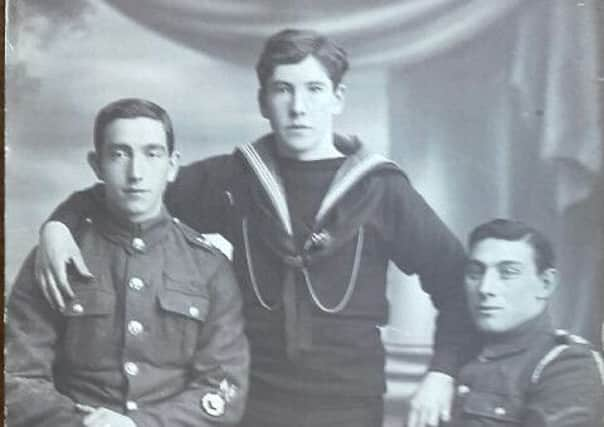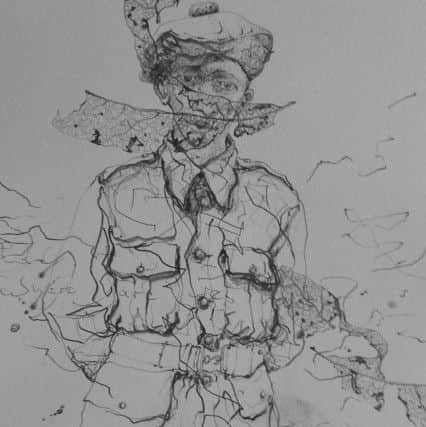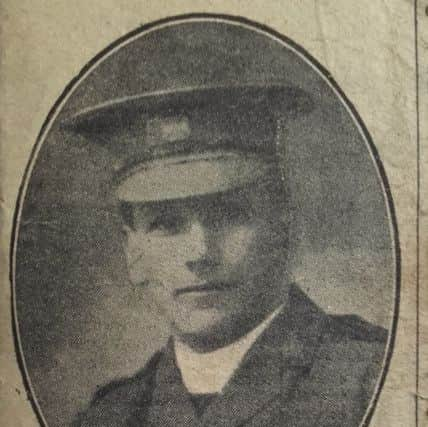Every picture tells a story but very few prompt a commemorative exhibition


Held in Stormont’s Long Gallery in June 2016, his drawings and paintings were mostly of soldiers’ and stretcher bearers’ faces, here and there studded with real mud and poppy seeds from the front lines at Messines which Leslie visited on his regular trips to First World War battlefields and war-torn landscapes.
The soldiers’ harrowing and haggard images were based on old, damaged, glass-plate negatives, sometimes cracked and caked with dust.
Advertisement
Hide AdAdvertisement
Hide Ad“It was mostly the expression in the soldiers’ eyes that caught me,” Leslie explained, referring to the exhaustion and fear so vividly captured in his paintings.


He put a lot of groundwork and research into his paintings, reading letters from the front lines, diary entries, autobiographies and visiting museums across Europe.
The project left Leslie with “an unshakeable wonder at the soldiers’ modesty and reticence at not being seen as heroes but as people doing what was expected of them,” he explained, adding “they were brave beyond words.”
Leslie is currently preparing another exhibition which has truly remarkable, and sad, beginnings.
Advertisement
Hide AdAdvertisement
Hide AdAfter his mother-in-law was diagnosed with severe dementia a year and a half ago, Leslie and his wife Elaine began the difficult and disheartening task of sorting through and clearing her house.


Elaine’s grandfather – Able Seaman Nicholas Crawford – served with the Royal Navy during First World War when he saw action at Jutland, and amongst the books and documents they found in the house were some of his old pay books, discharge papers and medals.
“When it came to the heavy furniture the both of us couldn’t do it on our own,” Leslie told me, “so we had to get a house clearance company.”
A small, square, dusty box was left behind in the loft.
“When I opened it,” said Leslie, “I was astonished to find First World War casualty lists from Monaghan, Armagh and Portadown newspapers.”


Advertisement
Hide AdAdvertisement
Hide AdThere was also a cutting bearing the photo of a padre, Reverend D S Corkey BA, captioned “wounded in France.”
Leslie was surprised because “I knew that face,” he recounted.
He collaborates with a painter called Colin Corkey who “lives in Lisburn, we live in Bangor and Elaine’s mum in Portadown, where the box had waited 100 years to be opened,” Leslie continued.
“When I contacted Colin to see if this man was a relative he was as staggered as I was to find out that it was his great uncle David and until that day the family had never seen a photograph of him in uniform.”


Advertisement
Hide AdAdvertisement
Hide Ad“I told the director of North Down Museum this story,” said Leslie “and I was invited to turn their Long Gallery into a kind of Memorial Chapel for November 2018” – the centenary of the end of First World War.
Colin will paint a triptych of his great uncle David from the photograph “giving Absolution to a long line of drawings of soldiers based on original glass-plate negatives of young servicemen from that time” said Leslie.
The painting of the Rev David Corkey giving Absolution will be powerfully poignant, revealing the remarkable story behind the short caption – “wounded in France” – on the old newspaper cutting.
“He lost an arm at the front line doing that very action,” explained Leslie, “giving Absolution to a dying man. He was mentioned in dispatches.”
Advertisement
Hide AdAdvertisement
Hide AdThe drawings of the soldiers lined up will be “laid flat and in glass cases as if it is a communal, mass grave,” Leslie explained “and around the walls will be a group of paintings of young soldiers from various combatant nations including a Sikh cavalryman, paying respects to their fellow countrymen.”
One of the drawings in a glass case is a soldier in a kilt, shrouded with falling Autumn leaves.
Some of the artworks “are being gifted to North Down Museum to raise money for the young men and woman returning from active service who now suffer from physical and mental trauma,” Leslie told me.
The exhibition is being supported by the Commonwealth War Graves Commission and the British Red Cross
Advertisement
Hide AdAdvertisement
Hide Ad“I never believed in ghosts but now I’m not so sure,” says the Bangor artist, “finding that box in the loft was meant to happen and having Colin paint his relative for the centenary of 1918 is a wonderful way to attempt to lay ghosts to rest, especially so as the young padre lived for only a couple of years after the end of First World War.”
Leslie says that the paintings and drawings are a big challenge for him “but how can they not be”.
He shares another photo here today, of wife Elaine’s grandfather, Able Seaman Crawford, shown in his Royal Navy uniform, standing between two infantrymen.
“We have tried to find out who they were but anyone who might have known are now dead,” said Leslie, noting that “the young guy on the left is in Signals.”
Advertisement
Hide AdAdvertisement
Hide AdAnyone in Signals would have been “in the front line, and, having to use semaphore flags to communicate, they suffered massive losses as they had to be out in the open so that the signal flags could be seen”.